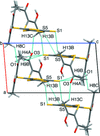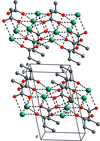issue contents
September 2020 issue

Cover illustration: Metallacrowns are macrocyclic molecules comprising a metal-nitrogen-oxygen repeat unit that typically bind a metal ion in their central cavity, showing a behaviour similar to that of crown ethers. Their potential applications include single-molecule magnetism, magnetorefrigeration, MRI contrast agents, as well as the formation of host-guest complexes, gas- and solvent-sorption materials and optical imaging agents, depending on the metal ions present in the ring and inside the cavity. The featured paper reports the synthesis and crystal structure of three isomorphous [3.3.1]metallacryptate macrocyles featuring an Al-N-O repeat unit complexing GdIII, DyIII and YbIII ions. These complexes could show interesting luminescent properties and/or single-molecule magnet behaviour. See: Rheam, Zeller & Zaleski [Acta Cryst. (2020). E76, 1458-1466].
research communications






















































 journal menu
journal menu












































